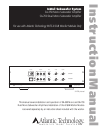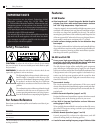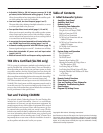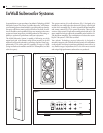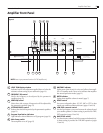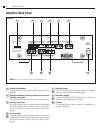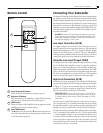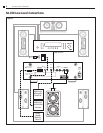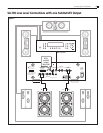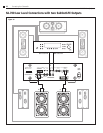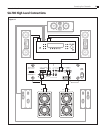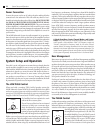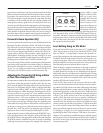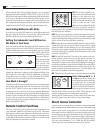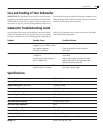
13
Instruction Manual
ing position to evaluate the sound.
Pay particular attention to the deep
bass as well as the transition of bass from the subwoofer to the satel-
lite speakers. You can also listen to a musical source such as a CD or
DVD, with strong bass content that spans the range from deep bass
to mid bass (a well recorded jazz disc with someone playing a full
stand up bass is always a good choice). It’s usually best not to use a
“one note” special effects track like a big explosion or dinosaur stomp-
ing to test the subwoofer. Experiment with the position of the PHASE
control(s) to get the most extended bass and the best transition from
sub to satellites. It should be obvious which is the correct setting. In
particular, there will be a smoother more integrated transition be-
tween the satellites and the subwoofer when they are properly phased.
Parametric Room Equalizer (EQ)
In order to optimize the performance of your InWall subwoofer the
Parametric Equalizer should be utilized. The built in Parametric
EQ(s) allow you to select the frequency you want to adjust, and how
wide a band on either side of that frequency you’re going to adjust
with it. They are designed specifically to remove (turn down) un-
wanted peaks in the bass. The procedure is fairly simple: the in-
cluded Atlantic Technology/Sencore Test and Training CD is used
along with a meter to define the single largest bass peak at the prime
listening position and then reduce it with the Parametric EQ.
The test and setup CD also includes a wealth of general information
concerning sound reproduction and home theater, in addition to
the test tones. Although one set of tones is intended for setting the EQ
“by ear” we very strongly recommend using a Sound Pressure Level
(SPL) meter or a Real Time Analyzer to set the Parametric EQ.
Adjusting the Parametric EQ Using a Meter
or Real Time Analyzer (RTA)
It’s important to complete all the preceding steps regarding speaker
setup before setting the parametric equalizer. Once they are com-
plete, insert the Atlantic Technology/Sencore Test and Training CD
into your CD or DVD player and go to Track 22, which contains bass
frequencies from 20Hz to 120Hz. Set the BASS LEVEL of a single
subwoofer channel to 75dB at the primary listening position. If you
are using an RTA, set it to at least 1/6
th
octave resolution and slow
response. Continue using Track 22 and measure the response of the
sub using at least a 1/6
th
octave resolution (Use slow response to
allow the meter to average the standing waves that build up in the
room). Chances are that you will find at least one significant peak
in the subwoofer’s range (between 20Hz and the crossover point set
on the sub or in the processor). Write down the center frequency of
the peak, how “wide” the peak is (by noting the upper and lower
frequencies where it starts and stops) and how high it is, in dB.
Begin setting the Parametric EQ by adjusting the FREQUENCY con-
trol to the approximate center frequency of the peak. Next adjust
the WIDTH control to the approximate width of the peak. Note that
the WIDTH control is calibrated in octaves. An octave is a doubling
or halving of any chosen frequency. For example, if the chosen fre-
quency is 40Hz, 1 octave
higher would be 80Hz,
and one octave lower
would be 20Hz. Since the
WIDTH control ranges
from 0.2 octave to 1.5 oc-
taves you see that you can
adjust a from a fairly nar-
row band to a fairly wide
band on either side of the center frequency, depending upon how
wide the peak is. Next, set the ATTENUATION control to the ap-
proximate –dB value to compensate for the peak. Measure the bass
response again and see if you have significantly reduced the overall
peak. You may need to fine tune any or all of the controls to smooth
the response as much as possible.
Level Setting Using an SPL Meter
If you only have an SPL meter, set the meter to “C” weighting and
“Slow” response then use Track 22 to set the BASS LEVEL to 75dB.
Next use Tracks 1-21 sequentially to measure the subwoofer re-
sponse. Take enough time with each measurement to allow the meter
to stabilize. Write down the measured level for each frequency, cov-
ering the range from 20Hz to the crossover point selected on the
subwoofer amplifier or in the receiver/processor. After you have de-
fined the peak, proceed as outlined above to reduce it.
When setting up a complete home theater we strongly recommend
that you use a Sound Pressure Level meter. At the time of this writ-
ing Radio Shack® has one that is very affordably priced (approxi-
mately $40) and works well. However, for the best result in setting
up the levels and the parametric EQ you would be much better served
by using a true audio test instrument with a Real Time Acoustic
Analyzer (RTA) like the Sencore® SP 295.
To use an SPL meter, turn on your system, put the Processor/Re-
ceiver in the Test Mode and set its main volume control to a moder-
ate volume level. If the volume control has a 0dB setting with minus
dB below and plus dB above 0, set the control to 0dB. Next, sit in the
prime listening position, set the SPL meter to the 70dB scale, Slow
Response, and C Weighting. Now, holding the meter pointed up and
in front of you, let the system cycle its test tone from speaker to
speaker. Check the meter and set every speaker (including the
subwoofer), to 75dB using the individual level settings in the Pro-
cessor/Receiver. You may have to use the Processor/Receiver’s main
volume control to get the left front speaker to 75 dB but from then
on use the receiver’s internal level adjustments. These are almost
always accessible through the Processor/Receiver’s remote control.
As tempting as it may be to set the subwoofer and/or surround
speakers higher than 75dB, set them to 75dB and see if you can ac-
climate to it. Try watching several different movies and keep in mind
that the goal is to have a system that sounds like you’re actually “in
the movie.” In most cases, you shouldn’t be consciously aware of the
surround output at all.
Operation
FREQUENCY WIDTH ATTENUATION
75 1.0 -10
25 125 0.2 1.5 -200dB
LOCATION EQ



